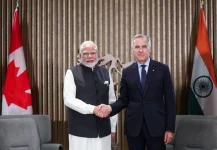- Views: 991
- Replies: 22
Canadian aerospace manufacturer Bombardier is set to offer its new Global 8000 business jet for the Indian Air Force’s (IAF) critical surveillance aircraft requirement.
The proposal comes as India’s Ministry of Defence is expected to give final approval this month for the acquisition of three advanced jets under the Intelligence, Surveillance, Target Acquisition, and Reconnaissance (ISTAR) program, aimed at bolstering the nation's defence against aerial threats from Pakistan and China.
The ISTAR initiative is designed to provide the IAF with a significant technological edge by enabling real-time, high-altitude monitoring of adversary movements and military assets. These aircraft will be crucial for maintaining battlefield transparency along the Line of Actual Control (LAC) and the Line of Control (LoC).
The new platforms will complement India's existing airborne surveillance assets, such as the Netra Mk1 Airborne Early Warning & Control (AEW&C) systems, and modernise an aging fleet currently operated by the Aviation Research Centre (ARC), which includes modified Gulfstream and older Bombardier Global 5000 jets.
The core of the ISTAR project involves outfitting the selected aircraft with a sophisticated suite of indigenous sensors. These critical technologies, developed by the DRDO's Centre for Airborne Systems (CABS), have already undergone successful testing, paving the way for their integration.
The IAF had previously considered the older Global 6000 model but has now shifted its focus to more modern aircraft with superior range and avionics to meet contemporary challenges.
Bombardier's Global 8000 is being presented as a strong candidate due to its exceptional performance characteristics. The aircraft boasts a remarkable range of 8,000 nautical miles (approximately 14,800 km) and can operate at a high-speed cruise of Mach 0.90. This long endurance and high operational altitude make it an ideal platform for lengthy surveillance missions.
Its spacious three-zone cabin is also adaptable for the specialised equipment required for intelligence gathering, signal interception, and secure communication links with satellites, drones, and ground forces. The jet is slated to officially enter service in 2025, aligning with the procurement timeline for the ISTAR program.
However, Bombardier's bid will face several considerations. Adapting a civilian business jet for a military role will require significant modifications, including the installation of advanced self-protection and defensive systems.
Furthermore, the proposal must align with the Indian government’s “Make in India” policy, which mandates technology transfer and local manufacturing partnerships.
The Canadian firm is expected to face competition from other international aerospace giants, including Boeing, which has also shown interest in the multi-billion dollar contract.
The final selection will likely depend on a comprehensive evaluation of operational capability, cost-effectiveness, and the extent of technology transfer offered.
To strengthen its proposal, Bombardier may seek partnerships with Indian defence firms, such as Tata Advanced Systems Limited (TASL), to manage the customisation and support for the aircraft in India.


